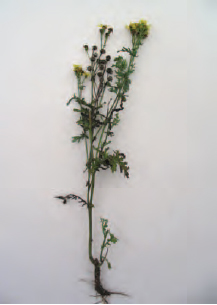Damage
Content
Problems caused by weeds may be categorized into seven main areas: Competition between the weed and the plant for water, nutrients and light may prove favourable to the weed if it is able to establish itself quickly. A large cleaver plant (Galium aparine), for example, may compete for a square metre of soil. The cultivated plants are therefore deprived of their major requirement and poor growth results. The extent of this competition is largely unpredict able, varying with climatic factors such as temperature and rainfall, soil factors such as soil type, and cultural factors such as cultivation method, plant spacing and quality of weed control in previous seasons. Large numbers of weed seeds may be introduced into a plot in poor quality composts or farmyard manure. The uncontrolled proliferation of weeds will inevitably produce serious plant losses.
Machinery such as mowing machines and harvesting equipment may be fouled by weeds, such as knotgrass, that have stringy stems Poisonous plants. Ragwort (see Figure 13.2), sorrel and buttercups are eaten by herbivorous animals when more desirable food is scarce. Also, poisonous fruits of plants such as black nightshade may be attractive to children and also contaminate mechanically harvested crops such as blackcurrants and peas for freezing. Seed quality is lowered by the presence of weed seeds. For example fat hen can contaminate batches of carrot seed. Tidiness is important for a well-maintained garden. The amenity horticulturist may consider that any plant spoiling the appearance of plants in pots, borders, paths or lawns should be removed, even though the garden plants themselves are not affected. Alternate hosts of pests and diseases. Pests and diseases are commonly harboured on weeds. Chickweed supports whitefly, red spider mite and cucumber mosaic virus in greenhouses. Sowthistles are commonly attacked by chrysanthemum leaf miner. Groundsel is everywhere infected by a rust which attacks cinerarias (see Figure15.9). Charlock may support levels of club root, a serious disease of brassica crops. Fat hen and docks allow early infestations of black bean aphid to build-up. Speedwells may be infested with stem and bulb nematodes. |
||||||||||||||||||||||||||||






